Annu Palakunnathu Matthew: Generations at the Royal Ontario Museum
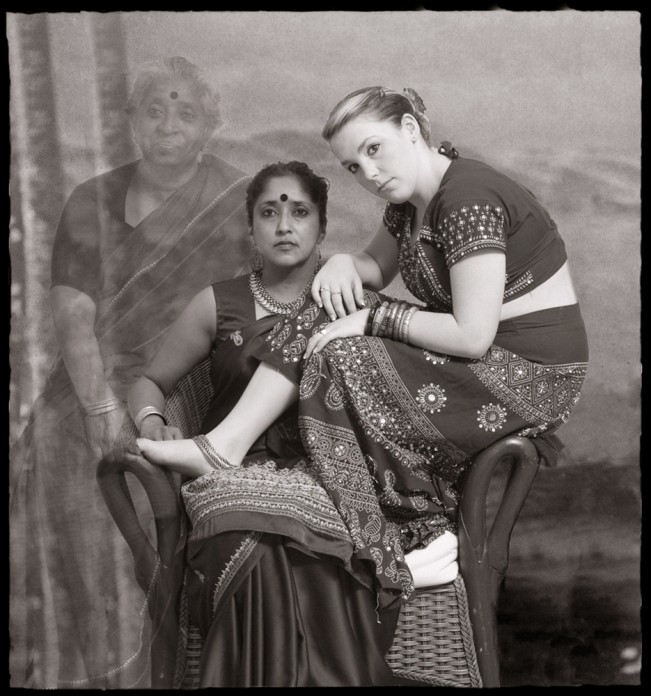
©Annu Palakunnathu Matthew, Re-Generation, India, Annu, 2011-2015, still from digital animation. Courtesy the artist and sepiaEYE.
Several weeks ago, I found myself in Toronto, my hotel directly across the street from the Royal Ontario Museum. Just days before, I received an e-mail from the museum alerting me to Annu Palakunnathu Matthew‘s retrospective exhibition, Generations, the primary exhibition for the 2015 Scotiabank CONTACT Photography Festival that opened on May 2, 2015. Needless to say, I was thrilled to be able to experience this wonderful photographic legacy by a photographer I so admire. The exhibition features six bodies of work created between 1996 and 2015 and is a combination of still and moving imagery that uses family photographs to explore how they shape identity and memory. It runs through October 18th, 2015.
Curated by Dr. Deepali Dewan, ROM Senior Curator of South Asian Arts & Culture, Generations reflects Annu’s creative approach to photography as a medium. The exhibition title plays with the dual concept of multiple generations within a family and photographic print. Presenting familiar imagery to draw in the viewer, Matthew uses the medium of photography to challenge the distance between past and present and the separation between fact and fabricated history.
“The family photograph is the most familiar, ubiquitous and numerous of any genre of photographyand yet, despite its popularity, remains notably absent from photo histories,” says Dr. Deepali Dewan, “In much of her work, Matthew brings focus on the family photograph, exploring its psychological and emotional dimensions to subvert cultural expectations.
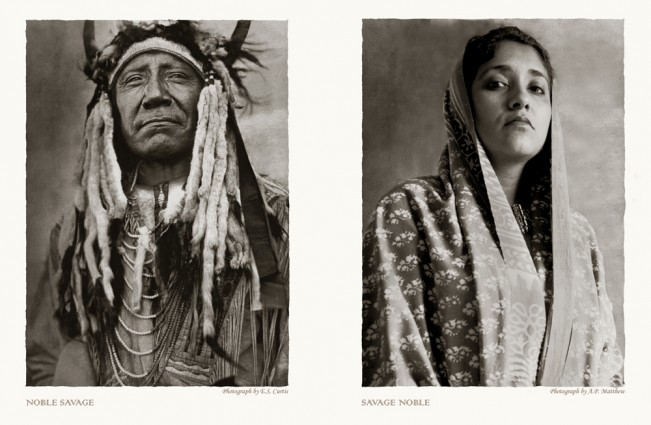
©Annu Palakunnathu Matthew, Indian from India, Savage, Portfolio I, 2001, digital print. Courtesy the artist and sepiaEYE. Original photo courtesy Northwestern University Library, Evanston, Illinois.
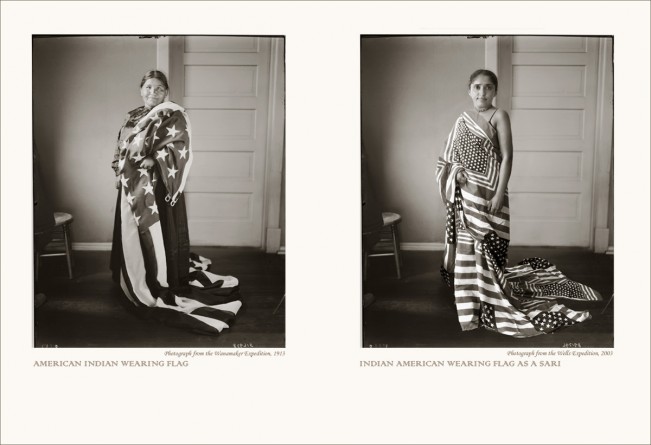
©Annu Palakunnathu Matthew, An Indian from India, Flags, Portfolio II, 2003, digital print. Courtesy the artist and sepiaEYE. Original photo courtesy Museum of Natural History, New York, NY Photograph from the Wanamaker Expedition, 1913
Congratulations on the fantastic new exhibition at the Royal Ontario Museum. Tell us how it came about.
One of the curators at the Royal Ontario Museum (ROM,) Dr. Deepali Dewan said that she has been following my work for years. She had the opportunity to curate a contemporary art show in connection with Toronto’s large photography festival called CONTACT and she chose my work. Her interest in old family photographs also dovetails with my use of them in my more recent work.
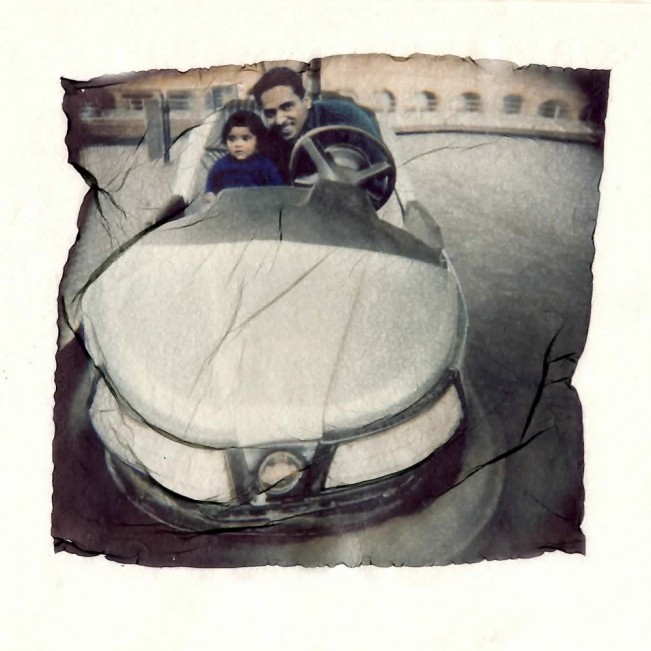
©Annu Palakunnathu Matthew, Fabricated Memories, 1997-2000, polaroid transfer artist book. Courtesy the artist and sepiaEYE.
What was the process like determining what would go in the show and how the exhibition flows.
Early on we decided that the work to be included would relate to the theme of “Generations” whether it conceptually connected to my work or the “generations” of techniques that I use across the various projects. There are six bodies of work in the show. All of them connect to memory is various ways. They are An Indian from India, Memories of India, Re-Generations, Open Wound, Fabricated Memories and To Majority Minority.
The projected movies from Open Wound and To Majority Minority became the central part of the layout. I love the fact that the space given to each body of work allows each portfolio to breathe. I think it is a quiet contemplative show compared to what we usually see in contemporary exhibitions.
The dialogue with Deepali reminded me that I have been using old family photographs from the start of my career. In 1998 I created a book using my own family photographs that explored my fathers early demise and questioned the subsequent decisions I made to become a photographer. The ROM has created an elegant installation of this small fragile book that is presented in a Chesterfield cigarette box because my father died from complications related to smoking. What I also appreciated about working with Deepali is that she was open to thinking about the installation as also being a sensory experience. So the area with the Fabricated Memories display includes the faint smell of tobacco. Similarly, Memories of India includes faint sounds of Ragas (Indian Music) playing in that corner of the gallery. The small black & white Holga photographs are interspersed with traditional Ragamala paintings from the ROM collection. The body of work An Indian from India is complimented with some of Edward S Curtis’ prints from his Native American work, which is some of the same imagery that I have used in my work. Being exhibited with Curtis has always been a dream.
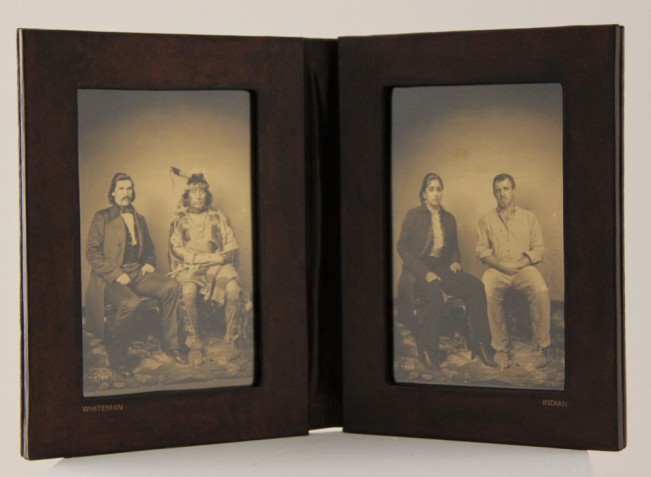
©Annu Palakunnathu Matthew, in collaboration with Cone Editions Ltd www.coneeditions.com, Indian from India—White Man with Indian / Indian with White Man, 2007-2009, digital orotones in leather case. Courtesy the artist and sepiaEYE. Original photo courtesy National Anthropological Archives, Smithsonian Institution, Washington DC.
So much of your work is tied to heritage, race, memory, and story telling. How has this investigation of self and history changed how you see the world and how you connect to certain cultures?
I see my work as reconsidering history and how it is perceived, told and retold. Photography is intrinsically connected to memory and I use that as a platform to dig into ways to get the viewer to reconsider their notions of history and those outside of the majority.
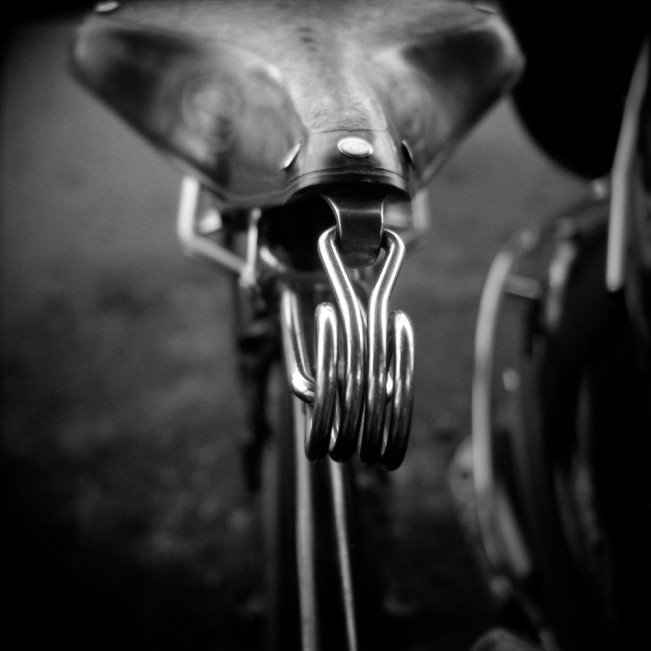
©Annu Palakunnathu Matthew, Memories of India, Bike Seat, 2002, gelatin silver print. Courtesy the artist and sepiaEYE
You state that you are “transcultural”. Has your photographic journey helped you feel rooted to one place?
I was born in England and spent 10 years of my life there before we moved to India. I left India when I was 28 and now live in the USA. So I have always lived between cultures. I celebrate that and those experiences have influenced and shaped my work. But no, photography itself has not helped me feel rooted to one place. As I have grown as a photographer, my work has helped me understand and celebrate being transcultural.
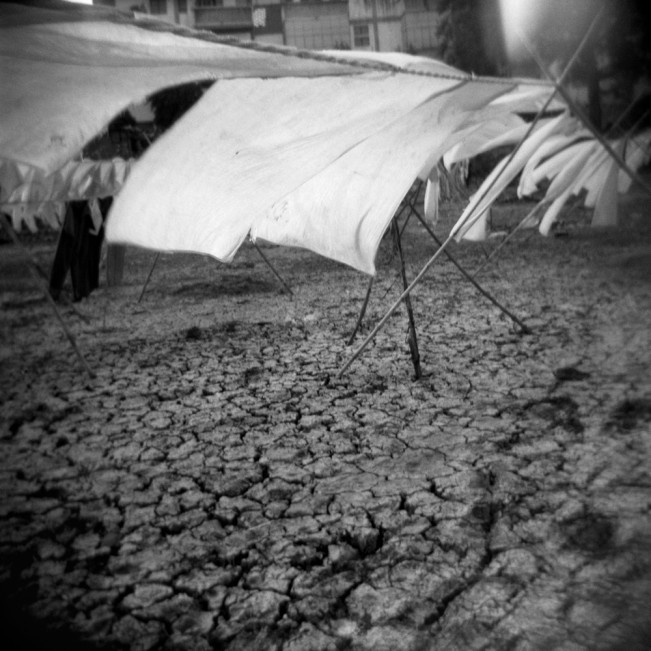
©Annu Palakunnathu Matthew, Memories of India, Billowing Fabric, 1998, gelatine silver print. Courtesy the artist and sepiaEYE.
Are you now more involved in tracing other transcultural stories more than your own?
As my husband says, my work is all about me, me, me! My latest work To Majority Minority explores my experience as a minority in the United States through the stories of others. The word “immigrant” conjures up images of families passing through Ellis Island or young men climbing across the Southwestern border fence. Yet it is more than that; it is the core of America, as an idea and a reality. We are a nation of immigrants, with an economy built on the labor of immigrants. Yet we fear and vilify them. Our love-hate relationship with immigrants reflects a duality. The America of yesterday, filled with immigrants of European descent is giving way to a new multicolored and multicultural America. By 2050, the populations we once called “minorities” will become the majority. This latest work looks into that change. I am exploring transcultural stories that collectively make up the Majority Minority America of the future. You already live amidst this future in California.
Ysabel
Ruchika
I am still working on To Majority Minority. In particular I would like more of a spectrum of ethnicities, socio-economic levels and backgrounds. Ideally I would like to get some funding to focus on California where the change that will occur in America as a whole in 2050 has already happened and thus reflects the future of the United States. Interested families can see more details at www.annumatthew.com/tomajorityminority/index.html
On Oct 3, I will be doing a special installation/presentation in Toronto as part of Nuit Blanche 2015, a free, all-night, contemporary art event, from sunset to sunrise for one night. My piece will be shown in the entrance of the Royal Ontario Museum (ROM.) The work The Virtual Immigrant, draws on the experience of call center workers in India who “become” North Americans for a workday, but remain physically in India. To work in these call centers, Indians study western culture and either neutralize their Indian accents or adopt western ones. In this process, the tangible markers of identity such as race, ethnicity, gender or class become more malleable for them.
The ethereal installation in the entrance of the Royal Ontario Museum (ROM) will consist of a projected large photo-animation depicting each worker alternating between his or her work clothes, usually perceived as more western, and the clothes that they would wear for a formal occasion, which are invariably more Indian. The audience can access the voices and stories of the call-center workers by calling a number or scanning a QR code available on site. The disembodied voices in the audio echo the dislocated experience of communicating with people hundreds or even thousands of miles away.
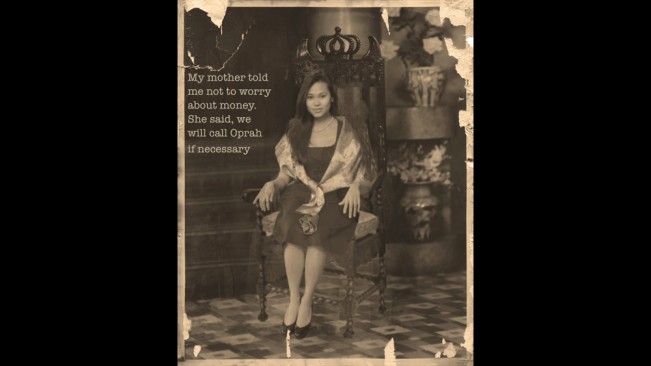
©Annu Palakunnathu Matthew, To Majority Minority, Ysabel, 2014, digital animation. Courtesy the artist and sepiaEYE.
And finally, describe your perfect day.
I would start a crisp sunny fall morning by going to the gym to focus my thoughts. Then I would immerse myself with my artwork. In the late afternoon, I would go for our usual afternoon walk to the local café with David, my husband. After working some more, we would then walk over to India Point Park (I am an Indian from India who lives near India Point Park!) and have a picnic by the bay, sipping wine. That would be one perfect day.
About the ROM
Opened in 1914, Canada’s largest museum of natural history and world cultures has six million objects in its
collections and galleries showcasing art, archaeology and natural science. The ROM is the largest field
research institution in the country, and a world leader in research areas from biodiversity, palaeontology, and
earth sciences to archaeology, ethnology and visual culture – originating new information towards a global
understanding of historical and modern change in culture and environment. For 24-hour information in English
and French, please call 416.586.8000 or visit the ROM’s web site at www.rom.on.ca. Tickets are available
online at www.rom.on.ca.
Scotiabank CONTACT Photography Festival
CONTACT is an annual festival of photography in Toronto, during the month of May, with over 1500 local,
national and international artists exhibiting at more than 175 venues. Founded as a not-for-profit organization in 1997 and granted charitable status in 2011, the festival is devoted to celebrating, and fostering the art and profession of photography. It stimulates excitement and discussion among a diverse audience that has grown to over 1.9 million visits. CONTACT is the largest photography event in the world, and a premier cultural event in Canada. For more information: scotiabankcontactphoto.com
Twitter @annu_matthew
ROM – @ROMtoronto
@ROMContemporary
#ROMFamCam
Posts on Lenscratch may not be reproduced without the permission of the Lenscratch staff and the photographer.
Recommended
-
Salua Ares: Absense as FormNovember 29th, 2025
-
Ricardo Miguel Hernández: When the memory turns to dust and Beyond PainNovember 28th, 2025
-
Pamela Landau Connolly: Columbus DriveNovember 26th, 2025
-
KELIY ANDERSON-STALEY: Wilderness No longer at the Edge of ThingsNovember 19th, 2025
-
Jackie Mulder: Thought TrailsNovember 18th, 2025












































































